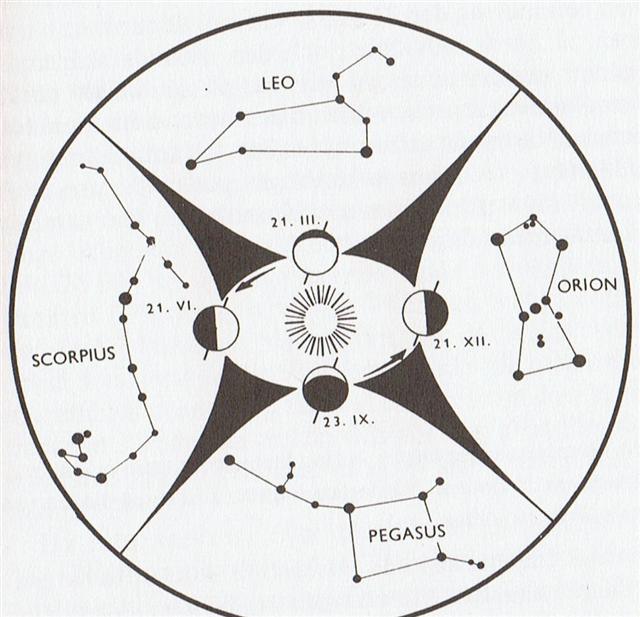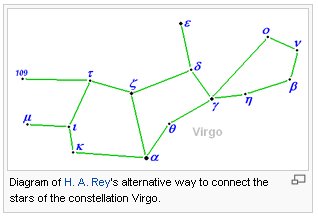5. The bird species which brings spring is not the same all over the world, but its characteristics should be similar. A pointed beak is necessary. In Sweden we have an old proverb, 'a single swallow does not make any summer', but this swallow is not a sea swallow (manu tara, the sooty tern) but a barn swallow. Another 'Spica' is the magpie (Pica). However, according to Robert Graves in his formidable The White Goddess its location is not early spring but winter solstice: Day of the Winter Solstice - A - aidhircleóg, lapwing; alad, piebald. Why is the Lapwing at the head of the vowels? Not hard to answer. It is a reminder that the secrets of the Beth-Luis-Nion [the ABC of the pre-latin Ogham alphabet] must be hidden by deception and equivocation, as the lapwing hides her eggs. And Piebald is the colour of this mid-winter season when wise men keep to their chimney-corners, which are black with soot inside and outside white with snow; and of the Goddess of Life-in-Death and Death-in-Life, whose prophetic bird is the piebald magpie.
From The Oxford Dictionary of English Etymology: piebald ... of two colours mingled, esp. white and black ... f. PIE¹ + BALD (in the sense 'streaked with white' ... pie¹ ... MAGPIE ... L. pīca magpie, rel. to pīcus green woodpecker, and Skr. pikás Indian cuckoo, and referred by some to IE. *(s)pl- be pointed ... magpie ... common European bird, Pica caudata, noted for its noisy chatter and pilfering habits ... f. Mag, pet-form of Margaret + PIE¹ ... Earlier (dial.) maggot-pie ... f. Maggot - (O)F. Margot, pet-form of Marguerite Margaret ... pie² ... dish composed of meat, etc., enclosed in paste and baked ... it has been conjectured that the reason for the application is that the magpie collects miscellaneous objects †chewet meat or fish pie (perh. identical with F. chouette †jackdaw, now owl) and HAGGIS have been compared ... haggis ... dish consisting of minced entrails of a sheep, etc., boiled in the maw of the animal ... of unknown origin; identity of form with †haggess magpie has suggested the possibility of its being a transf. use of the source of this, (O)F. agace, agasse magpie - OHG. agaz(z)a ... Black at the back and white in front does not imply winter solstice. It instead implies summer solstice, when the uri season of spring changes to the white of Moon. But if you determine the time of summer solstice by observing a star standing still in the night, it is a matter of terminology if we call it a stice in 'summer' or a stice in 'winter'. To make this more clear we can consider the following pictures (from my elementary astronomy book) which on one hand illustrates how - because of our planet's movement around Sun - it looks as if Sun advances through the zodiac in summer north of the equator, and on the other hand what constellations his path goes through at the other end of the sky vault in winter (or when observing the night sky in summer):
South of the equator an observer will find Sun in the same constellation as another simultaneous observer north of the equator will do. And the changes between night and daytime are also the same (for a given longitude). But the season of the year north of the equator is a mirror image of the season south of the equator, because the axis of the earth is not standing straight up. Rigel in Orion can be seen in the nights of December (XII). And in June (VI), when Taurus is rising heliacally, Antares in the Scorpion will be visible in the night sky. North of the equator Antares announces the arrival of winter and south of the equator Antares announces the arrival of summer. Virgo (where Spica is the dominant star) stands in zenith around autumn equinox north of the equator and around spring equinox south of the equator. But she rises heliacally in the middle of summer (respectively in the middle of winter), because noon lies ca 6 hours after sunrise and 6 / 24 is 25 % of the cycle (and 25 % of 12 months = 3 months or the distance from equinox to solstice). Virgo (the virgin) is the only female zodiacal constellation, surely a Sign, and we can decode its meaning as Sun is 'entering into her house'. The result will be a new Sun (Son), and Spica, her Alpha star, should appropriately be represented by her ear (the spike of corn). Ears are also the openings in the head between the side of the face and the back side. From the outside such an ear looks like a hole, but from the inside it looks like a spike. In this picture (from Wikipedia) the new Sun is inside an inverted 'bush':
... Virgo is traditionally ruled by the planet Mercury ... Under the tropical zodiac, the Sun is in Virgo roughly from August 23 to September 23, leaving it at the moment of autumnal equinox, by definition ... When Sun is arriving to Virgo (and Spica) it signifies that he will be 'swallowed'. South of the equator you have to look in the night sky to perceive the same sign of approaching autumn equinox. On Tahiti Spica was named Ana-Roto, which can be translated as 'the pit from which rises the star pillar' (ana) named 'middle' (roto):
The low position of Spica in comparison with the stars of my 'sky ladder' surely is a Sign of Sun's abrupt drop from his earlier position, which he had reached by climbing high up on the sky ladder. South of the equator it is early spring and the 'harvesting' of Sun is thus not relevant, he is being reborn instead of being 'swallowed'. However, stars are not watched in the daytime and during the night Spica can be seen around autumn equinox - her location is defined by the rest of the constellations. |




